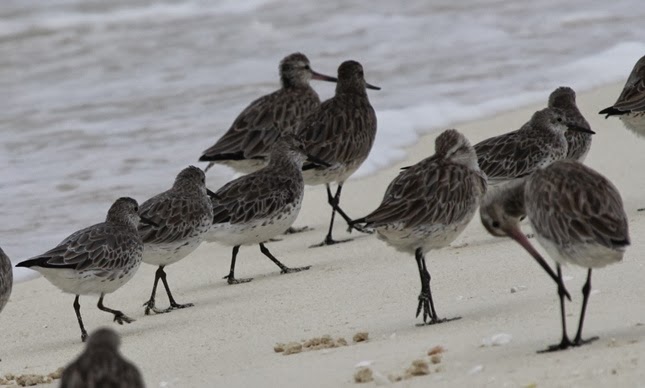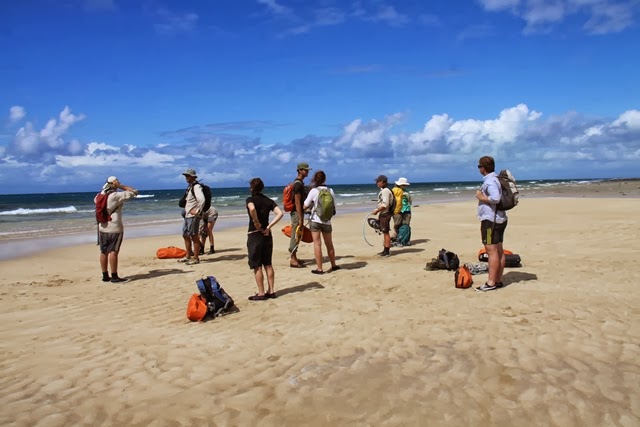I forgot to
mention that it’s very hot and sweaty in Paradise! And there are no showers or
other ablution resources on Northwest Island. So an hour after dawn I gave up
trying to doze through the never-ending noddy chorus and wandered down to the
beach, past those nesting turtles that hadn’t quite finished concealing their
repository of eggs, for a 5:30 am swim. Even at that hour the water was
beautifully refreshing, though it did leave its salty stickiness to prickle my
skin for the next little while. This would be my routine for the next few days.
 |
| The shallow reef waters were just perfect for swimming - or for an early morning bathe before the heat of the day set in; with no facilities for showering, this was virtually a requirement. |
The work
ethic for the first two to three days was fairly protestant. A 6:00 am start,
breakfast over and cleared up by 7:00, surveying from 7:30 until lunchtime, and
a few more hours after lunch to finish off for the day. Following this basic
schedule, most teams would be done by mid- to late-afternoon. Sometimes, a team
might decide to work through lunch and finish their transects for the day by
early- to mid-afternoon. Either way, there was usually time at the end of the
day for people to relax, chat around camp, go swimming, explore the beaches, or
do some birdwatching.
 |
| "Camp" was the centre point of our activities - a hub for socialising and of course eating. The catering by Amanda from Wild Mob was excellent and she did a remarkable job given the conditions. |
 |
| Buff-banded Rails (Gallirallus philippensis) are generally shy and elusive on the mainland but tend to be much more brazen on islands of the Great Barrier Reef and will readily come into camp for free handouts. |
It was a hard
slog in the hot and humid conditions but, thankfully, there was reasonable
cloud cover much of the time, and generally a decent breeze; so not as bad as
it could have been. Things were made more difficult by the snowshoes. Yep –
snowshoes! Never before, I think, have 17 pairs of snowshoes been taken to a
tropical island. Bemusement would turn to amusement as the purpose of the
snowshoes was explained to the few campers on the island who were intrigued enough
by our activities to ask. But their use, despite being cumbersome and awkward,
was worthwhile to minimise the number of burrow collapses we caused as we made
our way through the soft sandy breeding grounds under the pisonia trees.
 |
| Snowshoes were worn when traipsing across the burrow-ridden sandy expanse of a shearwater colony to minimise the risk of collapsing burrows. Awkward, cumbersome, and ludicrous in appearance, but effective. Other essential equipment included a "waddy" (1 m length of garden hose), a measuring tape, water and a hat.(Photo courtesy of Chris Lloyd) |
 |
| Feeling for Wedge-tailed Shearwaters in burrows and counting Black Noddy nests in trees - the two key elements to surveying each plot. (Photo courtesy of Chris Lloyd) |
Every so
often, walking between survey plots, you would come across something a little
unexpected. A huge spider on the trunk of a tree you’ve just put your hand on
for balance, or an immaculately manicured path (a shearwater runway) in the
middle of nowhere. Or your attention might be drawn by a Capricorn Silvereye
(the local island subspecies of Silvereye) fossicking in the shrubberies; or
yet another species of tiny jumping spider (the islands seemed to be over-run
with these) looking at you from a pisonia leaf.
+20140110_103328.jpg) |
| This beautifully manicured pathway over-arched by pisonia boughs leads to - nowhere! - it is not man-made at all. It is a shearwater "runway", that we happened across between survey plots at the eastern end of Northwest Island. It is the result of many thousands of shearwater feet pattering along, night after night, to aid their take off as they head out to feed in the surrounding seas. (Photo courtesy of Jade Fennell) |
 |
| The islands of the Capricorn Group have their own subspecies of Silvereye known, not surprisingly, as the Capricorn Silvereye (Zosterops lateralis chlorocephala) - more robust and with some differences in life history, it is sometimes regarded as a distinct species, the Capricorn White-eye. |
+20140110_092204.jpg) |
| This huge huntsman spider (Family Sparassidae) was quietly minding her own business on the trunk of a pisonia tree we had just passed. Thanks to Jade for the use of her camera for this photo. |
 |
| Jumping spiders (Family Salticidae) seemed to be everywhere on the islands: brown ones, grey ones, starkly black and white ones, and this one beautifully marked in crimson, brown, green and white. At the time I had my 400 mm lens attached and the photo had to be taken from more than 2 m away, so it's unfortunately a bit too blurry to see the immaculate colour scheme. |
 |
| This young female St Andrews Cross Spider (Argiope keyserlingi, Family Araneidae) was on Masthead Island. |
Late on the
afternoon of the second full survey day I was wandering along the beach and came across a high tide wader roost.
There were over 150 birds of 14 species all milling about on the beach or
perched on the sun-and-salt bleached fallen trees.
 |
| High tide wader roost - heaven for a birdwatcher! Species present were Bar-tailed Godwit, Wandering Tattler, Grey-tailed Tattler, Great Knot, Common Greenshank, Ruddy Turnstone, Pacific Golden Plover, Lesser Sand Plover, Greater Sand Plover, Australian Pied Oystercatcher, Silver Gull, Crested Tern, Lesser Crested Tern and Little Tern. |
 |
| Even with a 400 mm lens I had to approach the birds slowly to get close enough to get enough shots to be sure I could subsequently ID all the species. I took 70 photos of this roost. |
 |
| Lesser Sand Plovers, a Greater Sand Plover, Pacific Golden Plover, Little Terns, a couple of Lesser Crested Terns, a godwit... |
 |
| Amongst the 18 Bar-tailed Godwits were five Great Knots - similar in plumage but smaller than the godwits, more portly, and with a shorter all-dark bill. |
 |
| Two of the trio of Common Greenshanks, with their long legs and long, slightly up-turned bills. |
 |
| The weathered branches of fallen casuarinas were a favoured perch for these Wandering Tattlers. |
After two and
a half days of surveying on Northwest Island we had it covered. All 223 survey plots
along the 25 transects had been completed. At this point, the “parkies”, the
“birdies”, and the film crew left the Wild Mob group and Northwest Island to
head down to Heron Island. But we were back again a few days later to pick up
the Wild Mob volunteers in order to survey Masthead Island an hour or so to the
south-west. Masthead Island (so named by Matthew Flinders in 1802 when it was
sighted in the distance “A low island was
seen from the mast head, bearing north at the supposed distance of six leagues,
of which Captain Cook does not make any mention”) is a smaller version of
Northwest Island but with no facilities at all and no campers, and the
surveying was completed in a matter of hours. The tide was in when we finished
so we had to wade out from the beach to a sandbar at the edge of the reef
platform to be picked up by Rod in the Reef
Heron’s tender.
 |
| Weary surveyors wading across the low tide reef flats to be picked up and taken back to the Reef Heron. |
 |
| Waiting our turn at the lee edge of Masthead Reef to be picked up in the tender. |
Back at
Northwest, we dropped off and farewelled the Wild Mob volunteers for the last
time and headed back to Heron Island. It was a pleasure and privilege to meet
and work with these guys. Their enthusiasm and commitment to the surveying,
which was not always pleasant or easy, made the job enjoyable and fun.
 |
| The 2014 survey team. |



+20140110_092204.jpg)











+20140110_103328.jpg)


